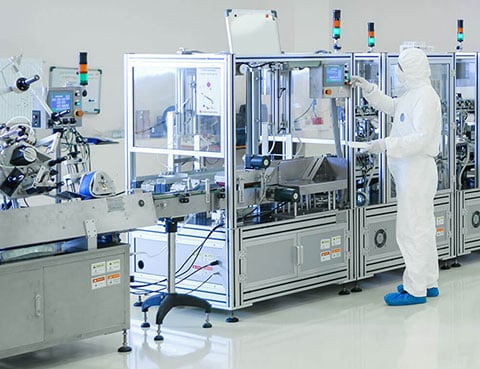Precision CNC Machining Services in the Medical Industry
CNCLATHING.COM, as a manufacturer engaged in CNC machining for many years, can offer medical machining parts with high speed and tight tolerances for surgical instruments and medical devices. With extraordinary technology and advanced equipment, we have become a leading China machined medical parts factory. We provide the customized medical prototyping process and various performance-critical medical component manufacturing services. In order to meet the low- or high-volume and high-precision development needs of medical equipment, medical-grade materials and advanced machining techniques are applied, and strict quality inspections will be carried out during our medical CNC machining process. We always deliver high-quality, precision CNC medical machined parts and products on time and at affordable rates.

Capabilities of Our Medical CNC Machining Services
Advantage of CNC Machined Medical Parts
- Affordable Prices – Always provide customers with the most cost-effective personalized production solution
- Quality Material – Green and durable materials meet the special needs of medical devices
- Custom Design – Design and produce any complex CNC medical part based on customer drawings and samples
- High Accuracy – Excellent design and production team ensures high accuracy of each CNC machined medical component
- Strong Capacity – Hundreds of state-of-the-art CNC machines for medical products can withstand mass production
- Fast Production – Provides reliable fast medical prototyping and rapid manufacturing solutions
- Excellent Service – Communicate production progress with customers in time and deliver on time

Applications of CNC Machining in the Medical Sector
CNC machining in the medical industry is widely used because it allows manufacturers to create highly precise and durable parts needed for medical devices and tools. The components of medical equipment are characterized by complex structure, tough materials, and difficult machining. CNC machining is the ideal method for manufacturing medical parts, using multi-axis CNC turning, milling, and other techniques. Unlike manual methods, CNC machining speeds up production while ensuring each piece meets strict quality standards, even when working with difficult materials. Common CNC medical parts include vertebral hooks, bone plates, bone screws, implant abutments, denture models, etc.

- Surgical instruments include scalpels, forceps, clamps, retractors, and bone drills.
- Orthopedic implants like hip replacements, knee replacements, spinal implants, and dental prosthetics.
- Dental implants, crowns, and surgical tools are used in dental procedures.
- Customized prosthetics and orthotic devices are designed for individual patient anatomy.
- Components for diagnostic equipment, including MRI machines, CT scanners, and blood analyzers.
- Cardiovascular devices such as stents and heart valves.
- Electronic medical equipment enclosures, mounts, and connectors for pacemakers and monitors.
- Endoscopic surgical tools in minimally invasive procedures.
- Ophthalmic devices, including laser surgery machines and vision diagnostic tools.
- Orthopedic hardware like screws, plates, and rods for bone support and alignment.
- Wearable medical devices that monitor vital signs and manage chronic conditions.
- Robotic surgery components include articulating arms and miniature surgical instruments.
- Bioresorbable implants that dissolve in the body after use.
- Microfluidic devices for precise fluid manipulation in diagnostics and drug delivery.
- Smart implants that are integrated with sensors for real-time health monitoring.
- Rehabilitation and assistive devices such as braces, supports, and mobility aids.
Common Methods & Processes for Medical Machining
✅ CNC Milling
CNC milling uses rotary cutting tools to precisely remove material from a workpiece and create medical machining parts with complex geometries and tight tolerances. It is widely applied in making orthopedic implants, surgical instruments, diagnostic components, and prototypes.
✅ CNC Turning
CNC turning involves rotating the workpiece against a cutting tool to shape cylindrical parts like pins, screws, and rods. It is ideal for fabricating components used in orthopedic implants, minimally invasive surgical instruments, and custom medical hardware.
✅ 5-Axis CNC Machining
5-axis CNC machining operates on five axes simultaneously, allowing the production of highly complex parts with exceptional precision. This technology is applied to make intricate surgical tools, advanced orthopedic implants, and customized medical components.
✅ Swiss CNC Machining
Swiss CNC machining excels at producing small, complex, and highly precise parts quickly. It is well-suited for high-volume manufacturing of intricate components, especially for minimally invasive surgical instruments, diagnostic devices, and electronic medical equipment.
✅ Wire EDM (Electrical Discharge Machining)
Wire EDM uses electrical discharges to cut electrically conductive materials with fine detail and minimal stress. This process is suitable for manufacturing precise medical parts for cardiovascular devices, surgical instruments, and custom prototypes requiring extremely tight tolerances.
✅ Laser Cutting/Engraving
Laser cutting and engraving provide precise cutting and marking on metals and medical-grade plastics. This method is commonly used for shaping prosthetic parts and adding identification marks or instructions on medical devices.
Materials Used in Medical CNC Machining
The materials used to manufacture CNC medical parts often require specific properties and features. For example, sterilization capability is an important factor to consider when choosing a proper material for the medical device. Medical components often interface directly with the human body or must endure harsh sterilization processes, so materials must be non-toxic, stable under thermal and chemical exposure, and mechanically reliable.
For healthcare parts and medical device machining, stainless steel, titanium, inconel, aluminum, PEEK, and some ceramic materials are the most commonly used because of their excellent properties, such as biocompatibility, high strength, corrosion resistance, strength-to-weight ratio, and more. Other materials, like specialty alloys, are used in niche cases requiring extreme performance. Plastics such as PEI and polycarbonate are frequently used for device housings, but less so for implants. Uncommon materials may have limited applications or require special machining techniques and higher costs.
|
Material Category |
Typical Material |
Uses |
Key Features |
Popularity |
|
Metals |
Stainless Steel (316L, 304) |
Surgical instruments, implants |
Corrosion resistant, biocompatible, strong |
Very Common |
|
Titanium (Ti 6Al-4V) |
Orthopedic implants, surgical tools |
Lightweight, strong, biocompatible |
Very Common |
|
|
Cobalt-Chrome Alloys |
High-stress implants (hip, knee) |
Wear-resistant, durable |
Common |
|
|
Aluminum (6061, 7075) |
Device housings, non-implantable |
Lightweight, corrosion-resistant |
Common |
|
|
Nickel-Titanium (Nitinol) |
Stents, catheters, orthodontics |
Superelasticity, shape memory |
Less Common |
|
|
Inconel |
High-temp, high-stress parts |
Temperature resistant, strong |
Less Common |
|
|
17-4 PH Steel |
Surgical tools, precision parts |
High strength, corrosion, and heat resistant |
Common |
|
|
Plastics |
PEEK |
Implants, surgical instruments |
High strength, chemical resistant, biocompatible |
Very Common |
|
PEI (Ultem) |
Sterilizable components |
High-temperature resistant, creep-resistant |
Common |
|
|
Polycarbonate (PC) |
Device housings |
Clear, impact-resistant |
Common |
|
|
UHMWPE |
Orthopedic implants |
Wear-resistant, low-friction |
Common |
|
|
Polypropylene (PP) |
Tubing, containers |
Chemical resistant, flexible |
Common |
|
|
Acrylic (PMMA) |
Lenses, instrument parts |
Clear, easy to fabricate |
Less Common |
|
|
PTFE |
Catheters, seals |
Low friction, chemical resistant |
Less Common |
|
|
Delrin (Acetal) |
Precision mechanical parts |
High stiffness, low friction |
Less Common |
|
|
Nylon, PVC, Kel-F (PCTFE) |
Various non-implantable parts |
Chemical resistant, durable |
Less Common |
|
|
Ceramics |
Alumina |
Dental, orthopedic implants |
Hard, biocompatible |
Less Common |
|
Zirconia |
Dental crowns, implants |
Strong, aesthetic |
Less Common |
|
|
Silicon Nitride |
Spinal, orthopedic implants |
Wear-resistant, biocompatible |
Rare |


